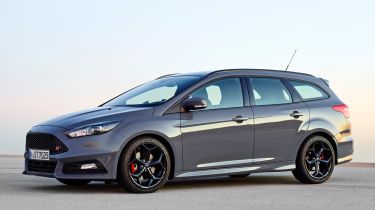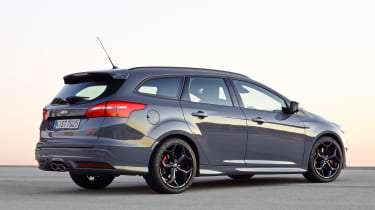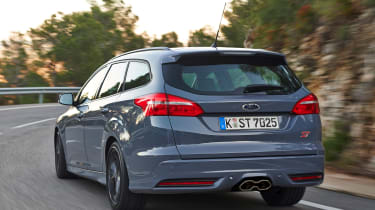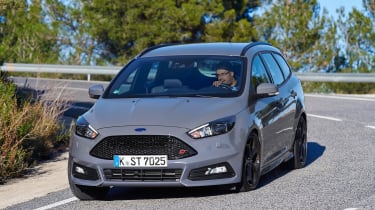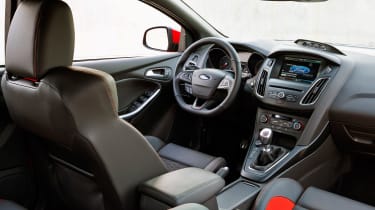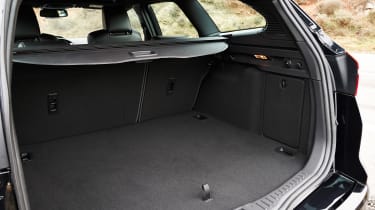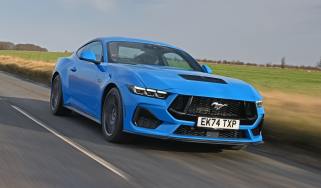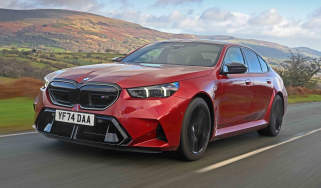Ford Focus ST Estate (2015-2018)
"The Ford Focus ST Estate is a no-compromise car: you get all the practicality of a family estate combined with the performance of a hot hatchback"
Pros
- Fun and engaging to drive
- Powerful and responsive engine
- More subtle and practical than hatchback
Cons
- Ride is quite firm
- Not suitable for towing
- Bigger estates are available
There was once a time that sporty estate cars were the exclusive preserve of premium brands. Arguably, BMW popularised the type with its first 3 Series Touring at the end of the eighties and since then other car makers have cottoned on to the fact that enthusiastic drivers appreciate practicality as well as speed.
The Ford Focus ST Estate is proof that Ford certainly gets the message. It takes all the ingredients that impress so much in the Focus ST hatchback – namely sharp steering, plenty of power, confidence-inspiring handling and distinctive looks – while rectifying that car’s main shortcoming: its rather meanly sized boot.
The Focus ST is every bit as capable a load-carrier as its less aggressively styled Focus Estate stablemates, with a 476-litre boot that can handle bulky furniture as easily as a pair of mountain bikes and tents. Granted, it’s not alone in being able to this – the Volkswagen Golf GTD Estate, SEAT Leon ST Cupra and Skoda Octavia vRS all do a good job of combining pace with space, but the Focus has the upper hand in some respects.
Not least is the way it handles, which is barely any differently from the ST hatchback on which it’s based. The engines are potent, too – the 247bhp 2.0-litre petrol is enough for 0-62mph in a shade under seven seconds. The 182bhp diesel is no slug, either – the automatic manages 0-62mph in less than eight seconds yet can exceed 67mpg.
More reviews
As has become the norm with Ford, the Focus ST is a well equipped car, yet still comfortably undercuts the Volkswagen Golf GTD Estate spec-for-spec. The Ford badge doesn’t have quite the same cachet as the VW emblem, but fast Fords have a fond following. There’s always a keen demand for used ST models and this helps them to maintain their value. Factor in a good safety score and the ST Estate looks a sensible and fun proposition for your family as well as your finances.
The standard Ford Focus finished 51st out of the 75 cars ranked in our 2017 Driver Power owner satisfaction survey of cars currently on sale in the UK.
MPG, running costs & CO2
The petrol Focus ST Estate petrol produces 247bhp and will accelerate from 0-62mph in 6.7 seconds – just two tenths of a second slower than the petrol hatchback version. Top speed is 154mph.
There's also a Focus Mountune tuning package too, which boosts power to 271bhp and makes the estate good for a 0-62mph in the 5.7 seconds range. While it's certainly faster, you get the feeling that the ST wasn’t optimised for quite this much power and many will find the standard model more enjoyable to drive.
Figures for the diesel are a little less impressive on paper – the 2.0-litre engine produces 182bhp, which is enough for an 8.3-second 0-62mph time and a top speed of 135mph. It certainly doesn’t feel sluggish, though, and when you consider just how low the fuel consumption is, these performance figures are pretty remarkable.
As well as being rapid in a straight line, the Focus ST estate is great in corners, with sharp steering, well judged ride quality and great agility on twisty roads. In the petrol model, you get a raspy engine note pumped straight into the cabin when you accelerate hard, but it settles down nicely for motorway cruising if you're not in the mood.
There can be some wheelspin if you accelerate hard (especially in the wet) so a degree of caution is needed. Strong brakes and a snappy, satisfying gearchange complete the car's highly involving driving experience.
Engines, drive & performance
The petrol Focus ST Estate petrol produces 247bhp and will accelerate from 0-62mph in 6.7 seconds – just two tenths of a second slower than the petrol hatchback version. Top speed is 154mph.
There's also a Focus Mountune tuning package too, which boosts power to 271bhp and makes the estate good for a 0-62mph in the 5.7 seconds range. While it's certainly faster, you get the feeling that the ST wasn’t optimised for quite this much power and many will find the standard model more enjoyable to drive.
Figures for the diesel are a little less impressive on paper – the 2.0-litre engine produces 182bhp, which is enough for an 8.3-second 0-62mph time and a top speed of 135mph. It certainly doesn’t feel sluggish, though, and when you consider just how low the fuel consumption is, these performance figures are pretty remarkable.
As well as being rapid in a straight line, the Focus ST estate is great in corners, with sharp steering, well judged ride quality and great agility on twisty roads. In the petrol model, you get a raspy engine note pumped straight into the cabin when you accelerate hard, but it settles down nicely for motorway cruising if you're not in the mood.
There can be some wheelspin if you accelerate hard (especially in the wet) so a degree of caution is needed. Strong brakes and a snappy, satisfying gearchange complete the car's highly involving driving experience.
For drivers looking for a more focussed experience, Ford Performance offers a range of go-faster parts, including coilover suspension manually-adjustable through 16 stages and lightweight alloy wheels.
Interior & comfort
The Ford Focus ST Estate is the same shape and size inside and out as the standard Ford Focus Estate and has largely the same interior. The two main differences are the addition of snug, supportive Recaro seats for the driver and front-seat passenger, as well as three extra dials on top of the dashboard giving you more information about what's going on under the bonnet.
As far as comfort goes, the ST Estate has the same slightly stiffer suspension as the ST hatchback, so you'll feel lumps and bumps in the road more readily than you would in a regular Focus. But this firmer suspension is one of the main reasons the ST Estate is so good to drive, so we think it's a trade-off worth making. It's not unbearably uncomfortable, either, striking a good balance between soaking up bumps and minimising body lean in corners.
Practicality & boot space
The Ford Focus ST Estate has a 476-litre boot, which expands to 1,502 litres when you fold the back seats down. The corresponding figures for the ST hatchback are 316 and 1,101 litres, yet performance and efficiency figures for the two models are almost identical, so there's very little penalty for choosing the estate.
The fast Focus isn't quite a match in this regard for the Skoda Octavia vRS Estate, which can pack in 238 more litres of luggage with its back seats down. On the plus side, the Focus does include handy touches such as shopping-bag hooks and a hidden underfloor storage area.
Space for passengers is good but not great – the sculpted Recaro rear seats leave the middle passenger in the back perched uncomfortably high, so you're better off carrying just two adults back there. Headroom and legroom in the back aren’t quite as good as in the Octavia vRS, either, but there are at least plenty of storage spaces for your odds and ends.
Reliability & safety
The Ford Focus was rated poorly for reliability in our 2017 Driver Power owner satisfaction survey of cars currently on sale in the UK. Of the owners who responded, 7.7% reported experiencing a problem with their car at least once.
Owners praise the handling and connectivity, but are less impressed with the ride comfort, exterior styling and practicality, marking down the popular hatchback for its ageing interior and poor build quality.
As for safety, the Focus Estate hasn't been crash-tested separately by Euro NCAP, but the hatchback version achieved the maximum five-star score when it was evaluated in 2012. Safety kit available on the ST includes airbags, lane-departure warning, a driver tiredness monitor, automatic braking, a cross-traffic alert system and lane-keeping assistance.
Price, value for money & options
The Focus ST Estate mirrors the trim levels of the ST hatchback, so every version is well equipped. The basic ST1 version includes 18-inch alloy wheels, a racy bodykit, DAB digital radio, Ford's SYNC infotainment system with voice control, Recaro sports seats, sports suspension and the Ford MyKey, which can be used to limit the car's top speed and stereo volume.
Upgrading to ST2 gets you automatically activated windscreen wipers and headlights, part-leather trim on the Recaro seats and dual-zone climate control. and It also has an eight-inch colour touchscreen with Ford’s latest SYNC 3 phone compatibility system that includes Apple CarPlay and Android Auto. The range-topping ST3 model boasts bright bi-xenon headlights, full leather trim, power-adjustable front seats and cruise control.
The most useful options for the Focus ST Estate include sat nav and a reversing camera for £750, as well as the £550 Driver Assistance Pack, which includes lane-departure warning, automatic emergency braking and automatically dipping headlights.
When assessing the Focus ST Estate against its rivals, there’s a clear-cut case for it as a good all-rounder with a sparkling driving experience. The Golf Estate is a little smarter inside and out but not quite as rewarding to drive, while the Skoda Octavia vRS puts greater emphasis on function than fun. The closest to a direct match of skills is the SEAT Leon ST Cupra.

